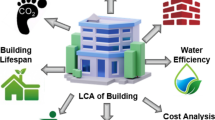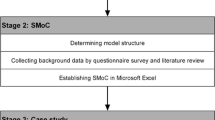Abstract
The life cycle sustainability assessment (LCSA) of construction activities has become a subject of considerable interest globally. However, researchers are mainly devoted to analyzing economic and environmental impact assessment of buildings, and there is a lack of a review of the studies on social impact assessment. Therefore, this study aims to review the quantitative methods for social life cycle assessment (S-LCA) in construction through the bibliometric method. Most of the studies on social impact analysis have adopted qualitative and quantitative methods and this study mainly focuses on the studies that used quantitative analysis methods for social life cycle assessment owing to the space limitation. This study found that the research interest in the life cycle sustainability assessment is gradually rising, primarily focusing on case studies, method comparisons, and new frameworks. However, because social impact assessment has significant limitations in the quantification of inventory, the choice of indicators, and the method of impact assessment, this study proposes that the development of social impact factors in the construction field requires to make more extraordinary efforts in the development of new methods, new software, new technologies, decision-supporting tools, and databases.
Access this chapter
Tax calculation will be finalised at checkout
Purchases are for personal use only
Similar content being viewed by others
References
UNEP. Buildings and construction sector—Huge untapped potential for emission reductions. Available online: https://www.unep.org/news-and-stories/press-release/buildings-and-construction-sector-huge-untapped-potential-emission. Accessed on January 2, 2021.
Finkbeiner, M., Schau, E. M., Lehmann, A., & Traverso, M. (2010). Towards life cycle sustainability assessment. Sustainability, 2(10), 3309–3322.
Kloepffer. W. (2008). Life cycle sustainability assessment of products. The International Journal of Life Cycle Assessment, 13(2), 89–95.
Ciroth, A., Finkbeier, M., Hildenbrand, J., Klöpffer, W., Mazijn, B., Prakash, S., Sonnemann, G., Valdivia, S., Ugaya, C. M. L., & Vickery-Niederman, G. (2011). Towards a live cycle sustainability assessment: making informed choices on products. UNEP/SETAC Life Cycle Initiative.
Kruse, S. A., Flysjö, A., Kasperczyk, N., & Scholz, A. J. (2009). Socioeconomic indicators as a complement to life cycle assessment—an application to salmon production systems. The International Journal of Life Cycle Assessment, 14(1), 8.
UNEP. Guidelines-for-Social-Life-Cycle-Assessment-of-Products. Available online: https://www.unep.org/resources/report/guidelines-social-life-cycle-assessment-products. Accessed on January 2, 2021.
Martínez-Blanco, J., Lehmann, A., Muñoz, P., Antón, A., Traverso, M., Rieradevall, J., & Finkbeiner, M. (2014). Application challenges for the social Life Cycle Assessment of fertilizers within life cycle sustainability assessment. Journal of Cleaner Production, 69, 34–48.
Fan, L., Pang, B., Zhang, Y., Zhang, X., Sun, Y., & Wang, Y. (2018). Evaluation for social and humanity demand on green residential districts in China based on SLCA. The International Journal of Life Cycle Assessment, 23(3), 640–650.
Liu, S., & Qian, S. (2019). Evaluation of social life-cycle performance of buildings: Theoretical framework and impact assessment approach. Journal of Cleaner Production, 213, 792–807.
Santos, P., Pereira, A. C., Gervásio, H., Bettencourt, A., & Mateus, D. (2017). Assessment of health and comfort criteria in a life cycle social context: Application to buildings for higher education. Building and Environment, 123, 625–648.
Yasantha Abeysundara, U. G., & Babel, S. (2010). A quest for sustainable materials for building elements in Sri Lanka: Foundations. Environmental Progress & Sustainable Energy, 29(3), 370–381.
Yung, P., & Wang, X. (2014). A 6D CAD model for the automatic assessment of building sustainability. International Journal of Advanced Robotic Systems, 11(8), 131.
Dong, Y. H., Ng, S. T. (2015). A social life cycle assessment model for building construction in Hong Kong. International Journal of Life Cycle Assessment, 20(8),1166–1180.
Karatas, A., & El-Rayes, K. (2015). Optimizing tradeoffs among housing sustainability objectives. Automation in Construction, 53, 83–94.
Invidiata, A., Lavagna, M., & Ghisi, E. (2018). Selecting design strategies using multi-criteria decision making to improve the sustainability of buildings. Building and Environment, 139, 58–68.
Kucukvar, M., Noori, M., Egilmez, G., & Tatari, O. (2014). Stochastic decision modeling for sustainable pavement designs. The international journal of Life Cycle Assessment, 19(6), 1185–1199.
Wu, M. H., Ng, T. S., & Skitmore, M. R. (2016). Sustainable building envelope design by considering energy cost and occupant satisfaction. Energy for Sustainable Development, 31, 118–129.
Hosseinijou, S. A., Mansour, S., Shirazi, M. A.(2014). Social life cycle assessment for material selection: A case study of building materials. International Journal of Life Cycle Assessment, 19(3), 620–645.
Balasbaneh, A. T., Marsono, A. K. B., & Khaleghi, S. J. (2018). Sustainability choice of different hybrid timber structure for low medium cost single-story residential building: Environmental, economic and social assessment. Journal of Building Engineering, 20, 235–247.
Flynn, K. M., & Traver, R. G. (2013). Green infrastructure life cycle assessment: A bio-infiltration case study. Ecological Engineering, 55, 9–22.
Kalutara, P., Zhang, G., Setunge, S., & Wakefield, R. (2017). Factors that influence Australian community buildings’ sustainable management. Engineering, Construction and Architectural Management, 24(1), 94–117.
Fraile-Garcia, E., Ferreiro-Cabello, J., Martinez-Camara, E., & Jimenez-Macias, E. (2015). Adaptation of methodology to select structural alternatives of one-way slab in residential building to the guidelines of the European Committee for Standardization (CEN/TC 350). Environmental Impact Assessment Review, 55, 144–155.
Neto, J. V., & De Farias Filho, J. R. (2013). Sustainability in the civil construction industry: An exploratory study of life cycle analysis methods. International Journal of Environmental Technology and Management, 16(5–6), 420–436.
Joglekar, S. N., Kharkar, R. A., Mandavgane, S. A., & Kulkarni, B. D. (2018). Sustainability assessment of brick work for low-cost housing: A comparison between waste based bricks and burnt clay bricks. Sustainable Cities and Society, 37, 396–406.
Saleem, M., Chhipi-Shrestha, G., Andrade, T. B., Dyck, R., Ruparathna, R., Hewage, K., & Sadiq, R. (2018). Life cycle thinking-based selection of building facades Journal of Architectural Engineering, 24(4), 04018029.
International Organization for Standardization. (2006). Environmental management: Life cycle assessment; principles and framework (No. 2006). ISO.
Navarro, I. J., Yepes, V., & Martí, J. V. (2018). Social life cycle assessment of concrete bridge decks exposed to aggressive environments. Environmental Impact Assessment Review, 72, 50–63.
Mohaddes Khorassani, S., Ferrari, A. M., Pini, M., Settembre Blundo, D., García Muiña, F. E., García, J. F. (2019). Environmental and social impact assessment of cultural heritage restoration and its application to the Uncastillo Fortress. International Journal of Life Cycle Assessment, 24(7), 1297–1318.
Hossain, M. U., Poon, C. S., Dong, Y. H., Lo, I. M. C., & Cheng, J. C. P. (2018). Development of social sustainability assessment method and a comparative case study on assessing recycled construction materials. International Journal of Life Cycle Assessment, 23(8), 1654–1674.
Dong, Y. H., & Ng, S. T. (2016). A modeling framework to evaluate sustainability of building construction based on LCSA. International Journal of Life Cycle Assessment, 21(4), 555–568.
Ostermeyer, Y., Wallbaum, H., & Reuter, F. (2013). Multidimensional Pareto optimization as an approach for site-specific building refurbishment solutions applicable for life cycle sustainability assessment. International Journal of Life Cycle Assessment, 18(9), 1762–1779.
Hu, M., Kleijn, R., Bozhilova-Kisheva, K. P., & Di Maio, F. (2013). An approach to LCSA: The case of concrete recycling. International Journal of Life Cycle Assessment, 18(9), 1793–1803.
Zheng, X., Easa, S. M., Yang, Z., Ji, T., & Jiang, Z. (2019). Life-cycle sustainability assessment of pavement maintenance alternatives: Methodology and case study. Journal of Cleaner Production, 213, 659–672.
Wang, J., Wang, Y., Sun, Y., Tingley, D. D., & Zhang, Y. (2017). Life cycle sustainability assessment of fly ash concrete structures. Renewable and Sustainable Energy Reviews, 80, 1162–1174.
Kono, J., Ostermeyer, Y., & Wallbaum, H. (2018). Trade-off between the social and environmental performance of green concrete: The case of 6 countries. Sustainability, 10(7), 2309.
Liu, S., & Qian, S. (2019). Towards sustainability-oriented decision making: Model development and its validation via a comparative case study on building construction methods. Sustainable Development, 27(5), 860–872.
Gencturk, B., Hossain, K., & Lahourpour, S. (2016). Life cycle sustainability assessment of RC buildings in seismic regions. Engineering Structures, 110, 347–362.
AENOR for Standardization. (2015). UNE-EN 16309:Sustainability of construction works—Assessment of social performance of buildings—Calculation methodology.
Chang, Y., Ries, R. J., & Wang, Y. (2011). The quantification of the embodied impacts of construction projects on energy, environment, and society based on I-O LCA. Energy Policy, 39(10), 6321–6330.
Papong, S., Itsubo, N., Malakul, P., & Shukuya, M. (2015). Development of the social inventory database in Thailand using input–output analysis. Sustainability, 7(6), 7684–7713.
Kucukvar, M., & Tatari, O. (2013). Towards a triple bottom-line sustainability assessment of the U.S. construction industry. International Journal of Life Cycle Assessment, 18(5), 958–972.
Shi, X., Mukhopadhyay, A., Zollinger, D., & Grasley, Z. (2019). Economic input-output life cycle assessment of concrete pavement containing recycled concrete aggregate. Journal of Cleaner Production, 225, 414–425.
Choi, K., Lee, H. W., Mao, Z., Lavy, S., & Ryoo, B. Y. (2016). Environmental, economic, and social implications of highway concrete rehabilitation alternatives. Journal of Construction Engineering and Management, 142(2).
Onat, N. C., Kucukvar, M., & Tatari, O. (2014). Integrating triple bottom line input-output analysis into life cycle sustainability assessment framework: The case for US buildings. International Journal of Life Cycle Assessment, 19(8), 1488–1505.
Leontief, W. (1986). Input-output economics. Oxford University Press.
Ghimire, S. R., & Johnston, J. M. (2017). A modified eco-efficiency framework and methodology for advancing the state of practice of sustainability analysis as applied to green infrastructure. Integrated Environmental Assessment and Management, 13(5), 821–831.
Yeheyis, M., Hewage, K., Alam, M. S., Eskicioglu, C., & Sadiq, R. (2013). An overview of construction and demolition waste management in Canada: A lifecycle analysis approach to sustainability. Clean Technologies and Environmental Policy, 15(1), 81–91.
Wang, Z., Jin, W., Dong, Y., & Frangopol, D. M. (2018). Hierarchical life-cycle design of reinforced concrete structures incorporating durability, economic efficiency and green objectives. Engineering Structures, 157, 119–131.
Castro, M. D. F., Mateus, R., & Bragança, L. (2017). Development of a healthcare building sustainability assessment method—Proposed structure and system of weights for the Portuguese context. Journal of Cleaner Production, 148, 555–570.
Malmgren, L., Elfborg, S., & Mjörnell, K. (2016). Development of a decision support tool for sustainable renovation—A case study. Structural Survey, 34(1), 3–11.
Matthews, N. E., Stamford, L., & Shapira, P. (2019). Aligning sustainability assessment with responsible research and innovation: Towards a framework for Constructive Sustainability Assessment. Sustainable Production and Consumption, 20, 58–73.
Margorínová, M., Trojanová, M., Decký, M., & Remišová, E. (2018). Noise costs from road transport. Civil and Environmental Engineering, 14(1), 12–20.
Amini, A. A., Mashayekhi, M., Ziari, H., & Nobakht, S. (2012). Life cycle cost comparison of highways with perpetual and conventional pavements. International Journal of Pavement Engineering, 13(6), 553–568.
Babashamsi, P., Md Yusoff, N. I., Ceylan, H., Md Nor, N. G., Salarzadeh Jenatabadi, H. (2016). Evaluation of pavement life cycle cost analysis: Review and analysis. International Journal of Pavement Research and Technology, 9(4), 241–254.
Pons, O., De la Fuente, A., & Aguado, A. (2016). The use of MIVES as a sustainability assessment MCDM method for architecture and civil engineering applications. Sustainability, 8(5), 460.
Lounis, Z., & McAllister, T. P. (2016). Risk-based decision making for sustainable and resilient infrastructure systems. Journal of Structural Engineering, 142(9), F4016005.
Bragança, L., Mateus, R., & Koukkari, H. (2010). Building sustainability assessment. Sustainability, 2(7), 2010–2023.
Lounis, Z., & Daigle, L. (2013). Multi-objective and probabilistic decision-making approaches to sustainable design and management of highway bridge decks. Structure and Infrastructure Engineering, 9(4), 364–383.
Ekener-Petersen, E., & Finnveden, G. (2013). Potential hotspots identified by social LCA—part 1: a case study of a laptop computer. The International Journal of Life Cycle Assessment, 18(1), 127–143.
Author information
Authors and Affiliations
Corresponding author
Editor information
Editors and Affiliations
Rights and permissions
Copyright information
© 2021 The Author(s), under exclusive license to Springer Nature Singapore Pte Ltd.
About this paper
Cite this paper
Jiang, X.Y., Yao, X.R., Lyu, S.N. (2021). Review of the Quantitative Analysis Methods for Social Life Cycle Assessment in Construction. In: Lu, X., Zhang, Z., Lu, W., Peng, Y. (eds) Proceedings of the 25th International Symposium on Advancement of Construction Management and Real Estate. CRIOCM 2020. Springer, Singapore. https://doi.org/10.1007/978-981-16-3587-8_86
Download citation
DOI: https://doi.org/10.1007/978-981-16-3587-8_86
Published:
Publisher Name: Springer, Singapore
Print ISBN: 978-981-16-3586-1
Online ISBN: 978-981-16-3587-8
eBook Packages: Business and ManagementBusiness and Management (R0)




